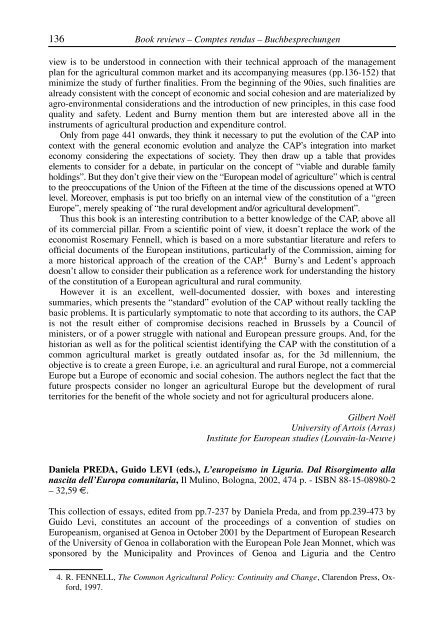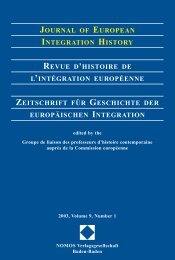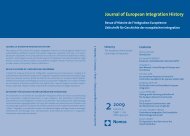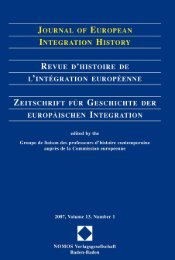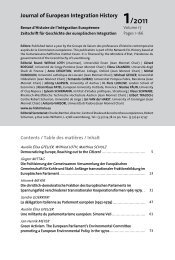136Book reviews – Comptes rendus – Buchbesprechungenview is to be un<strong>de</strong>rstood in connection with their technical approach <strong>of</strong> the managementplan for the agricultural common market and its accompanying measures (pp.136-152) thatminimize the study <strong>of</strong> further finalities. From the beginning <strong>of</strong> the 90ies, such finalities arealready consistent with the concept <strong>of</strong> economic and social cohesion and are materialized byagro-environmental consi<strong>de</strong>rations and the introduction <strong>of</strong> new principles, in this case foodquality and safety. Le<strong>de</strong>nt and Burny mention them but are interested above all in theinstruments <strong>of</strong> agricultural production and expenditure control.Only from page 441 onwards, they think it necessary to put the evolution <strong>of</strong> the CAP intocontext with the general economic evolution and analyze the CAP’s <strong>integration</strong> into marketeconomy consi<strong>de</strong>ring the expectations <strong>of</strong> society. They then draw up a table that provi<strong>de</strong>selements to consi<strong>de</strong>r for a <strong>de</strong>bate, in particular on the concept <strong>of</strong> “viable and durable familyholdings”. But they don’t give their view on the “European mo<strong>de</strong>l <strong>of</strong> agriculture” which is centralto the preoccupations <strong>of</strong> the Union <strong>of</strong> the Fifteen at the time <strong>of</strong> the discussions opened at WTOlevel. Moreover, emphasis is put too briefly on an internal view <strong>of</strong> the constitution <strong>of</strong> a “greenEurope”, merely speaking <strong>of</strong> “the rural <strong>de</strong>velopment and/or agricultural <strong>de</strong>velopment”.Thus this book is an interesting contribution to a better knowledge <strong>of</strong> the CAP, above all<strong>of</strong> its commercial pillar. From a scientific point <strong>of</strong> view, it doesn’t replace the work <strong>of</strong> theeconomist Rosemary Fennell, which is based on a more substantiar literature and refers to<strong>of</strong>ficial documents <strong>of</strong> the European institutions, particularly <strong>of</strong> the Commission, aiming fora more historical approach <strong>of</strong> the creation <strong>of</strong> the CAP. 4 Burny’s and Le<strong>de</strong>nt’s approachdoesn’t allow to consi<strong>de</strong>r their publication as a reference work for un<strong>de</strong>rstanding the <strong>history</strong><strong>of</strong> the constitution <strong>of</strong> a European agricultural and rural community.However it is an excellent, well-documented dossier, with boxes and interestingsummaries, which presents the “standard” evolution <strong>of</strong> the CAP without really tackling thebasic problems. It is particularly symptomatic to note that according to its authors, the CAPis not the result either <strong>of</strong> compromise <strong>de</strong>cisions reached in Brussels by a Council <strong>of</strong>ministers, or <strong>of</strong> a power struggle with national and European pressure groups. And, for thehistorian as well as for the political scientist i<strong>de</strong>ntifying the CAP with the constitution <strong>of</strong> acommon agricultural market is greatly outdated ins<strong>of</strong>ar as, for the 3d millennium, theobjective is to create a green Europe, i.e. an agricultural and rural Europe, not a commercialEurope but a Europe <strong>of</strong> economic and social cohesion. The authors neglect the fact that thefuture prospects consi<strong>de</strong>r no longer an agricultural Europe but the <strong>de</strong>velopment <strong>of</strong> ruralterritories for the benefit <strong>of</strong> the whole society and not for agricultural producers alone.Gilbert NoëlUniversity <strong>of</strong> Artois (Arras)Institute for European studies (Louvain-la-Neuve)Daniela PREDA, Guido LEVI (eds.), L’europeismo in Liguria. Dal Risorgimento allanascita <strong>de</strong>ll’Europa comunitaria, Il Mulino, Bologna, 2002, 474 p. - ISBN 88-15-08980-2– 32,59 €.This collection <strong>of</strong> essays, edited from pp.7-237 by Daniela Preda, and from pp.239-473 byGuido Levi, constitutes an account <strong>of</strong> the proceedings <strong>of</strong> a convention <strong>of</strong> studies onEuropeanism, organised at Genoa in October 2001 by the Department <strong>of</strong> European Research<strong>of</strong> the University <strong>of</strong> Genoa in collaboration with the European Pole Jean Monnet, which wassponsored by the Municipality and Provinces <strong>of</strong> Genoa and Liguria and the Centro4. R. FENNELL, The Common Agricultural Policy: Continuity and Change, Clarendon Press, Oxford,1997.
Book reviews – Comptes rendus – Buchbesprechungen 137Regionale Ligure <strong>of</strong> the European Fe<strong>de</strong>ralist Movement. Starting with the nineteenthcentury origins <strong>of</strong> Ligurian Fe<strong>de</strong>ralism, it goes on to analyse the contribution <strong>of</strong> the regionto the construction <strong>of</strong> the Community, both in its governmental and non-governmentalaspects, extending the investigation to some sectors which have hitherto been neglected byhistoriography, such as the attitu<strong>de</strong> <strong>of</strong> the local economic administrations and organisations.Since the first half <strong>of</strong> the nineteenth century Genoa and the Ligurian territory have playedan important role in the spread <strong>of</strong> Europeanism. A city <strong>of</strong> traffic and commerce, a crossroads<strong>of</strong> men and i<strong>de</strong>as, Genoa could not long remain untouched by that national and internationalturmoil which Europe had been plunged into from the early years <strong>of</strong> the nineteenth century,and which in a short time was to result in an arrangement <strong>of</strong> the civil world according to theprinciple <strong>of</strong> nations, as stated by Daniela Preda in her lengthy and well documentedintroduction to this volume.The first essay is by Bianca Montale and is <strong>de</strong>dicated to a concept or i<strong>de</strong>a <strong>of</strong> Europeproposed by a famous Genoese from the nineteenth century, Giuseppe Mazzini, who, ratherthan being a Fe<strong>de</strong>ralist, could better be <strong>de</strong>scribed as being a forerunner <strong>of</strong> Fe<strong>de</strong>ralism.Although there are constant references to European cultural unity in his writings, Mazzini,does not actually mention Fe<strong>de</strong>ralism, but rather Friendship, i<strong>de</strong>ntifying Italy’s mission asthat <strong>of</strong> promoting the moral unity <strong>of</strong> Europe. His Europeanism shuns the juridical ties infavour <strong>of</strong> a supranational character, worried that the former could damage the absolutein<strong>de</strong>pen<strong>de</strong>nce and sovereignty <strong>of</strong> the newly-formed nations. Notwithstanding this, his i<strong>de</strong>asare still relevant today, claims Montale, when he makes precise references to the necessity <strong>of</strong>a close inter<strong>de</strong>pen<strong>de</strong>nce between political unification and economic <strong>integration</strong>.Danilo Veneruso, in his essay entitled “Giuseppe Garibaldi, le nazionalità, la dimensioneeuropea e l’internazionalismo”, studies the <strong>of</strong>ten forgotten internationalistic aspects <strong>of</strong> anotherfamous Genoan, Giuseppe Garibaldi. Veneruso, in fact, shows how in the figure <strong>of</strong> Garibaldi thenational and international aspects which characterised the popular liberation movement <strong>of</strong> themid-nineteenth century were strictly connected, and resulted in a sort <strong>of</strong> structure <strong>of</strong>ever-wi<strong>de</strong>ning concentric circles which were to culminate in “the reform <strong>of</strong> society”.In the period between the two world wars Genoa had an active role in the attempt tocreate a new international or<strong>de</strong>r based on Wilsonian principles. In particular the city playedhost to one <strong>of</strong> the three so-called “Great Diplomatic Conferences” <strong>of</strong> 1922: the EconomicConference, which is <strong>de</strong>alt with in this volume by A<strong>de</strong>le Maiello, tried, along with those <strong>of</strong>Cannes and The Hague, to overcome and remediate the <strong>de</strong>ep fractures <strong>of</strong> the systemresulting from the Treaty <strong>of</strong> Versailles. If, on the one hand, the conference proved to be atotal failure, it was on the other, as A<strong>de</strong>le Maiello claims, the occasion when an importantand innovative experiment in international co-habitation was carried out, in the convictionthat the crises <strong>of</strong> those years could be resolved using politico-diplomatic “weapons”,adopting a system <strong>of</strong> agreements among the great powers.It is precisely in that inter-war period, when it seemed evi<strong>de</strong>nt that the power <strong>of</strong> Europeas the political and economic centre <strong>of</strong> the world was on the wane, that Europeanismabandons many <strong>of</strong> those utopian i<strong>de</strong>als and attitu<strong>de</strong>s which had up to now formed part <strong>of</strong> itscharacter, in or<strong>de</strong>r to prepare itself as a political solution to the crisis <strong>of</strong> the continent.During that period Genoa, in particular, welcomed several important figures who wouldprove to be pr<strong>of</strong>oundly significant for the hamiltonian fe<strong>de</strong>ralist form <strong>of</strong> Europeanism inItaly, which would now be distinguished by its more general attitu<strong>de</strong> in favour <strong>of</strong> the unity<strong>of</strong> the continent in or<strong>de</strong>r to propose precise institutional solutions and clear cultural andtheoretic mo<strong>de</strong>ls <strong>of</strong> reference. Pietro Graglia in his interesting essay “L’europeismo aGenova nel periodo tra le due guerre” draws attention to the early writings <strong>of</strong> Luigi Einaudi,to those <strong>of</strong> his collaborator Attilio Cabiati and <strong>of</strong> Giovanni Agnelli, and also to the birth <strong>of</strong>the <strong>journal</strong> “Pietre” which would count, amongst others, Eugenio Colorni, futurecompanion-in-exile <strong>of</strong> Altiero Spinelli and Ernesto Rossi at Ventotene, as its collaborators.


